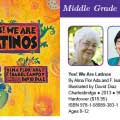
A Hispanic bilingual ed teacher explains how she stands up for her student at school.
It was windy and cold that December day. It had to be 29 degrees outside, I thought, but I’m no weather girl. Some misbehaving high school student had just pulled the fire alarm and the football field was filled with coatless teachers, students, and a grumbling staff. The class huddled together like Antarctic penguins seeking warmth. Beyond the mass, stands Luis, a Guatemalan newcomer. He’s fighting the cold with somersaults.
Amidst my wind-induced tears, I see Luis. I marvel at how his short limbs display his aptitude for gymnastics. His face is like a textured ceiling, marked up and oily, the effects of fluctuating teenage hormones. “¡Que talento, Luis!” I reply to his acrobatic aptitude. I want him to know that in the midst of acquiring English, regardless of how he trips the language up, he is worthy of respect.
He arrived into my ESL Level 1 class in late December. Luis had gotten lost on his second day of school, not uncommon for a new student. The bell sounded and students were off, racing to other classes, but Luis remained behind. “You’re going to be late.” I said, as I walked toward him. “I forgot where I have to go,” he sheepishly replied. “That’s okay, Luis. Show me your schedule.” I said.
I leaned against the lockers, and watched Luis fish through his book bag. I wished he would hurry, I remember thinking, because I had lunch duty that day. Finally, a crumpled class schedule emerged from his cavernous book bag. With a nervous smile, he handed it to me. He had study hall with another teacher. “This room is upstairs, vamonos.” I said.
We walked across the entire width of the school, cut through students, and arrived late. As I pulled the door open, Luis’ study hall teacher met me at the door. “He got lost, sorry he’s late,” I began. “Well he got here yesterday without a problem.” He curtly responded. I sensed his sarcasm. “It’s only his second day,” I reminded him.
Luis headed toward the back of the room and sat with two other ESL students. “¿Porque lo dejastes? El se perdió.” They had seemed uncomfortable, and had refused to respond. “Can you remind him of what’s expected in study hall, gentlemen.” I asked them. “Claro, Miss.” They whispered back, almost in unison.
I had given up on making eye contact with the distant teacher. He had refused to acknowledge my presence. I exited quickly, and walked straight to lunch duty. I brushed off his dismissive behavior. Yet the uncomfortable exchange that we had had stayed with me because I could not believe that a seasoned educator had not exercised patience with a new student who had simply gotten lost.
CONFLICTING TEACHER STYLES
I had just had an uncomfortable encounter with a colleague, my first in my three years of teaching. It had been obvious that maintaining order in the classroom had been important to him but I left the classroom exchange angry because I had assumed that in the 21st century, teacher attitudes towards recently arrived immigrant students would have been more accepting. I had sorely been reminded that not all teachers feel the same when it comes to handling relationships with English language learners.
I had not liked the words that he had used when I explained to him why Luis had arrived late. I believe all humans, no matter their age or language, should be treated with dignity. All students deserve the right to pursue an education and feel safe in their learning environments. Some teachers consider English Language Learner (ELL) classes as remedial. However, I see myself as an educator who teaches historical content in a specialized manner. I tried to forget about my colleague’s comment. I tried to forget about what I had witnessed, how he had hardly given Luis so much as a glance. Perhaps focusing on the upcoming noche buena revelries of pasteles and coquito would help me forget.
ADJUSTING TO SCHOOL
By January, Luis was adjusting to the rhythms of the classroom. He wasn’t afraid to raise his hand, he offered answers in class. He had been willing to write in English, regardless of the linguistic confounds. Luis was making progress.
One day, after I had just wrapped up a long day teaching a double period of ESL 1, I noticed that Luis had stayed behind—long after his classmates had exchanged fist bumps and goodbyes. “Miss, quiero hablar con usted,” he began. “Claro, Luis.” I smiled. He had stood there, his hands were hidden in his pockets; he kicked the floor with the tip of his sneaker. “Why is the study hall teacher so mean? El es tan malo conmigo.”
I immediately straightened up in my chair. “What happened?” I felt like a protective lioness—Luis was my cub. “I lost my pencil,” he said quietly. “I only wanted to borrow the teacher’s pencil to fill out a hall pass. He said, No. I wondered if it was my accent. So I asked him again. But again, he refused.
I immediately opened my desk drawer. There sat four, yellow pencils, with nubby, pink rubber ready to erase small mistakes of those learning English. “Here are a couple of pencils, Luis. Try not to lose them.” I smiled as I handed them to him. He returned a fleshy grin, “Gracias, Miss. Eres buena.” Off he ran to catch his bus.
STANDING BY HER CUB
The eternal souls of previous ELL educators must have cheered in heaven as I mustered up the courage and confronted the other teacher. I would not “toe the line.” I had to face him regardless of my non-confrontational personality.
“It must be cross-cultural communication,” he insisted. “I am business-like. You be careful now, those ELLs’ know a lot more than they let on.” He insisted. I came to realize that I, too, needed to consider the other teacher’s point of view. Perhaps his goal had wanted to teach Luis responsibility regarding the importance of carrying school supplies. Luis, meanwhile, has gotten better about remembering his school supplies.
Privately, however, I wondered if the teacher had shared our exchange because I noticed that one of his close colleagues had begun to treat me differently. I soon became the Hester Prynne of my school. Two members of his department return my smile with icy glares. And while I would prefer to work smoothly with all of the teachers, I will wear my ‘scarlet letter’ with pride. I am willing to partake in a little civil disobedience if it makes a teacher question how he treats the “ELLs,” and maybe even treats these students with dignity. I’m also realistic. I know that while census data show a high percentage of newly arrived immigrants in schools across America, it is against the backdrop of anti-immigrant news coverage and political rhetoric, and that not every teacher is going to receive these students with arms wide open.
In the end, I remind myself that Luis’ writing development is what matters most. Luis is worth two Ticonderoga pencils and so much more.
[Mamiverse’s Bilingual Plus is an online channel devoted to bringing parents and educators the bilingual learning tools they need in the form of digital picture books, sing-alongs, and free curriculum-based family activities.]












